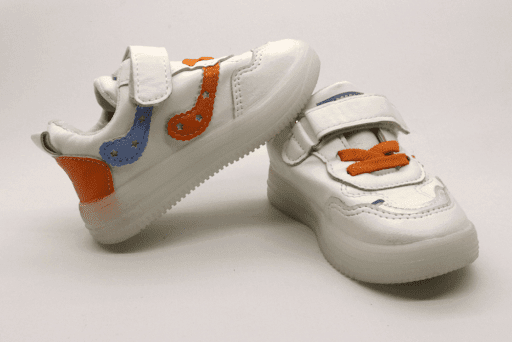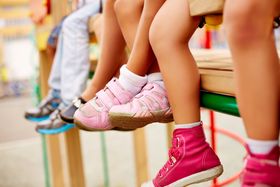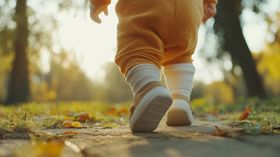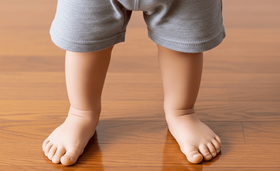Why Hard-Bottom Shoes Are Essential for Babies: Ensuring Stability and Support
Discover the benefits of hard-bottom shoes and how they can help your baby's feet grow strong and healthy.
Published September 8, 2024

As your baby begins to take those first wobbly steps, giving them footwear that supports their growing feet is essential. While soft, flexible shoes are suitable for newborns and early crawlers, hard-bottom shoes offer the necessary stability, protection, and support for their first independent steps.
Let's explore the benefits of hard bottom shoes and how they contribute to healthy foot development.
» Give your kid stable and supportive first steps with hard-bottom shoes
The Importance of Proper Footwear
The first few years of a child's life are critical for foot development. Their feet' bones, muscles, and ligaments still form and grow, making them particularly susceptible to external influences.
Proper footwear plays a vital role in:
- Supporting natural foot development
- Promoting proper walking patterns
- Protecting delicate feet from injury
- Providing stability as children learn to balance and walk
» Learn more about gait abnormalities in children
Why Choose Hard Bottom Shoes?
Hard bottom shoes offer several benefits for babies who are starting to take their first steps:
- Enhanced Stability: The firm sole provides a stable surface, reducing wobbling and supporting balance. This is particularly important as babies are still developing their sense of equilibrium and learning to coordinate their movements.
- Protection: Hard soles shield delicate feet from sharp objects, rough surfaces, and temperature extremes. This is crucial as babies start to explore different terrains, both indoors and outdoors.
- Proper Foot Alignment: They help maintain good foot alignment, essential for developing a healthy arch and overall gait. Good alignment early in life can prevent potential foot problems later in life.
- Durability: Hard soles can withstand more wear and tear than soft shoes, making them a practical choice for active toddlers.
- Improved Gait Development: They provide a firm base by promoting a heel-to-toe walking pattern. This natural rolling action is crucial for developing a proper walking technique and can help prevent issues like toe-walking.
- Sensory Feedback: While providing firm support, they also allow for sensory feedback from the ground. This tactile information helps babies learn how to adjust their walking style based on different surfaces and textures.
» Learn how to protect your child's feet from injury
When to Switch to Hard Bottom Shoes
Timing is everything when it comes to transitioning to hard-bottomed shoes. Every kid is different, but here's a general idea of when to start thinking about them.
- Crawling Stage: Soft shoes or booties are best for newborns and babies learning to crawl. These allow for natural foot movement and minimal restriction.
- Early Walking Stage: You can introduce slightly firmer soles as your baby pulls themselves up and holds on furniture. While hard soles can be introduced during the pre-walking stage, flexible soles are also sufficient.
- Independent Walking: The ideal time to change to hard-bottom shoes is when your baby starts walking independently. This typically occurs around 12–18 months old but can vary from child to child.
Even after introducing hard-bottom shoes, barefoot time benefits foot development in safe environments.
» Explore the best shoes for babies learning to walk
Key Features to Look for in Hard Bottom Shoes
When selecting hard-bottom shoes for your baby, aim for these essential features:
- Firm Soles: Look for soles that provide stability and support without being too rigid. The sole should have some flexibility to allow for natural foot movement.
- Arch Support: Proper arch support helps maintain correct foot alignment and prevent issues like flat feet.
- Heel Support: A supportive heel cup offers additional stability and helps limit excessive foot sliding within the shoe.
- Flexible Toe Box: While the sole is firm, the toe box should be flexible enough for natural toe movement and spreading.
- Non-Slip Outsole: A textured, non-slip outsole prevents slips and falls on surfaces ranging from smooth floors to outdoor terrain.
- Breathable Materials: Choose shoes made from breathable materials like leather to keep feet comfortable and prevent excessive sweating.
- Adjustable Closure: Velcro straps or adjustable laces ensure a snug fit and allow for easy on and off.
- Lightweight Design: Despite the firm sole, the overall shoe should be lightweight to prevent fatigue during wear.
» Check out these exercises to prevent flat feet in kids
Foot Conditions Hard Bottom Shoes Can Help
Hard bottom shoes can be particularly beneficial for babies with certain foot conditions:
- Flat Feet: Many babies have flat feet, which is often a normal part of development. Hard bottom shoes with good arch support can help distribute weight properly and reduce strain on the foot's ligaments and muscles.
- Pronation: Some babies may overpronate, which means their feet roll inward excessively while walking. Firm soles can help control this excessive inward rolling by providing additional support and stability.
- Weak Ankles: For babies with weak ankles, the stability provided by hard-bottom shoes can help strengthen the muscles and ligaments around the ankle joint.
» Read about important child feet care tips every parent should know
Addressing Common Misconceptions
There are several myths about hard-bottom shoes that are worth addressing.
Myth 1: Hard-bottom shoes are uncomfortable for babies.
Reality: Well-designed hard-bottom shoes feature supportive yet flexible soles and cushioned insoles for comfort.
Myth 2: Hard soles hinder natural foot development.
Reality: Quality hard-bottom shoes promote healthy foot development by providing necessary stability and support while allowing for natural movement.
Myth 3: Babies only need hard-bottomed shoes when they're fully walking.
Reality: While soft soles are suitable for pre-walking stages, introducing hard-bottom shoes as babies walk independently can provide crucial support and protection.
» Debunk these common myths before buying shoes for your child
Tips for a Smooth Transition
Switching to hard-bottom shoes can be a big change for your little one. Here are some tips to make the process easier:
- Gradual Introduction: Start by having your baby wear the new shoes for short periods each day, gradually increasing the duration as they become accustomed to them.
- Ensure Proper Fit: Regularly measure your baby's feet and choose shoes with some growing room. Aim for about a thumb's width of space between the toe and the shoe's end.
- Monitor Comfort: Pay attention to signs of discomfort, such as redness, blisters, or reluctance to walk. These may indicate a poor fit or the need for a different style.
- Allow Barefoot Time: Encourage barefoot time in safe environments to promote natural foot strength and sensory development.
- Regular Check-ups: Schedule regular check-ups with a paediatrician or podiatrist to monitor your baby's foot development and address any concerns early.
» Check out these tips when buying orthopaedic shoes for your kid
Supporting Your Baby's Journey
As your baby transitions from crawling to cruising and finally to those exciting first steps, their footwear needs change, too. Hard-bottom shoes support this journey, offering the stability, protection, and alignment that growing feet require.
By choosing well-designed hard-bottom shoes with critical features like firm soles, arch support, and breathable materials, you're not just buying footwear but investing in your child's foot health and overall development.
» Provide your baby with the best support and stability with hard-bottom shoes
Disclaimer: First Walkers' information is intended for educational and informational purposes related to toddler footwear and feet. We encourage you to consider individual circumstances and consult qualified orthopaedists about specific conditions.





